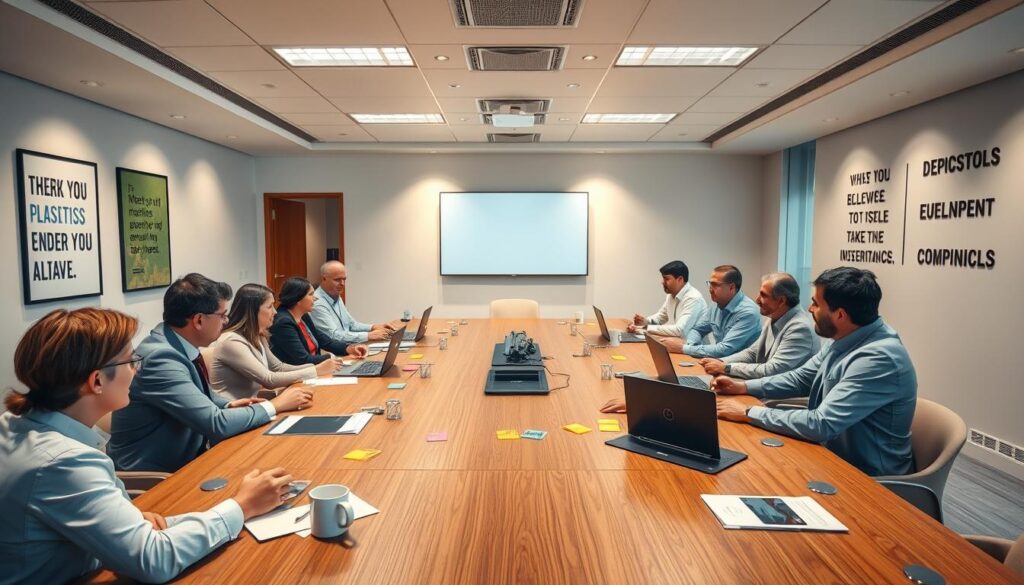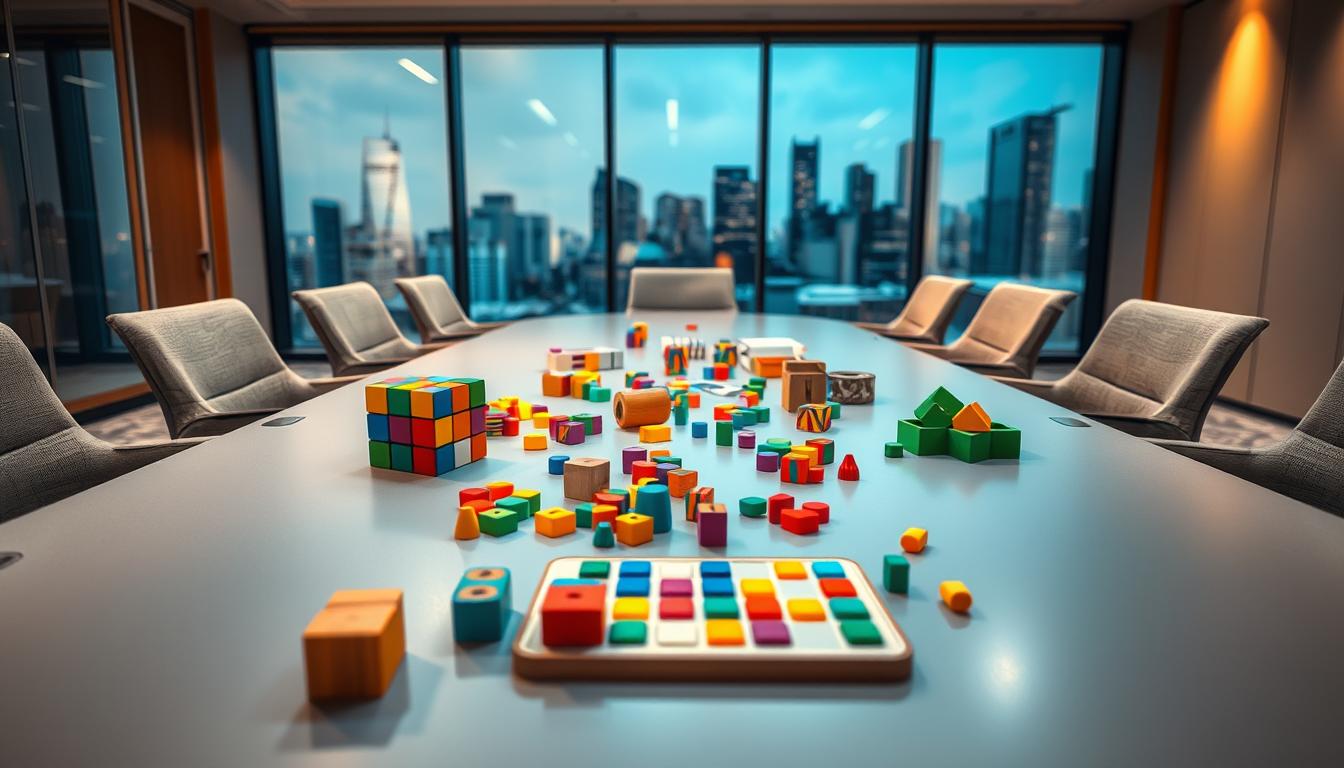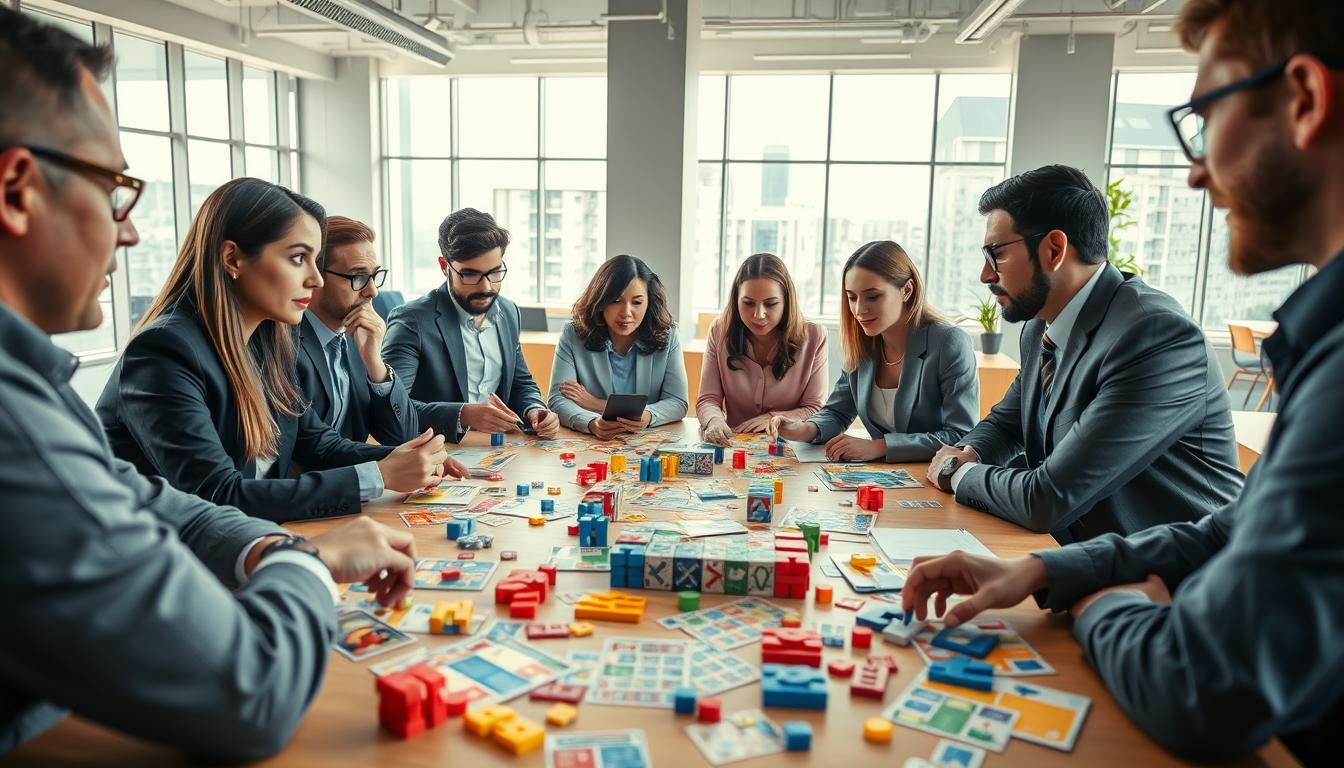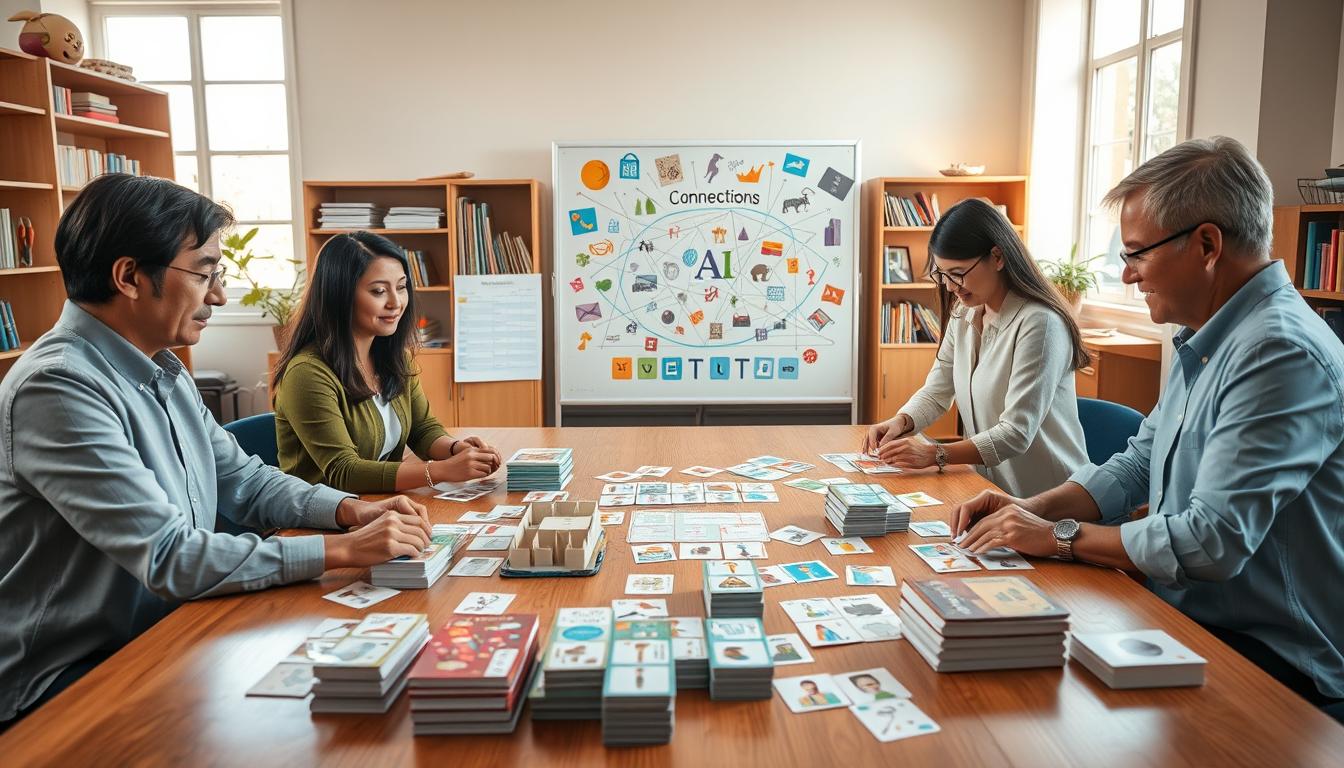Educational games to keep the mind sharp during long and demanding meetings
Ever wondered why meetings often feel endless? They leave us feeling mentally tired and disconnected. In today’s world, we need ways to stay focused more than ever. Educational games are becoming key in keeping minds sharp during meetings.
They boost creativity and make meetings more lively. This article will explore how adding fun activities to meetings can improve productivity and teamwork.
Introduction
Meetings are key in any organization. They help with communication and making decisions. But, long talks can make team members lose interest.
It’s vital to keep everyone engaged during meetings. Companies are now using interactive games to make meetings better. These games help keep the atmosphere lively and improve learning during training.
Adding educational games to meetings boosts energy and encourages learning. This makes meetings more productive. It keeps everyone focused and involved in the discussions.

The Importance of Mental Agility in Meetings
Mental agility is key in making meetings effective. It lets people think fast and adjust their answers quickly. This skill is not just about speed but also about using cognitive skills for better communication.
In fast-paced decision-making, mental agility makes sure everyone’s voice is heard. It captures important insights.
Studies show that better mental agility helps remember what’s discussed. When people think both analytically and experientially, they remember more. This makes understanding complex topics easier.
Teams do better when people are mentally agile. They can tackle challenges more effectively, leading to better teamwork and new ideas. Practices that boost this skill make meetings more interesting. They also help organizations learn and adapt continuously.
Understanding Engagement and Focus
Engagement is key to productive meetings. Keeping focus can be tough. Adults often find it hard to stay focused during long meetings.
Using different techniques, like switching between content and activities, helps. This keeps everyone’s attention sharp and minds engaged.
Adding activities that get people moving helps too. Interactive discussions and games cut down on mental tiredness. These strategies keep everyone involved and make meetings more effective.
They also create a space where ideas can easily share. This leads to better teamwork.
Benefits of Educational Games in Meetings
Educational games bring many benefits to meetings. They boost employee engagement, making meetings more fun and interactive. This change keeps everyone interested and helps team members feel more connected.
Games also help improve learning retention. They make learning more dynamic, helping participants remember important information better. This way, everyone can learn together and share ideas.
Moreover, games promote teamwork and creative problem-solving. They encourage people to work together and share ideas. This teamwork is key to meeting success and making sure everyone’s voice is heard.
Mental Agility Games for Meetings
Mental agility games are key tools to boost cognitive skills and make meetings lively. They offer a fun way to learn, encouraging everyone to get involved. There are many types of games to choose from.
- Task-based challenges: These exercises push participants to finish tasks fast, boosting quick thinking and decision-making.
- Role-playing scenarios: Role-play helps team members see things from different angles, improving understanding and empathy.
- Quick problem-solving exercises: These activities focus on fast ideas and teamwork, enhancing engagement through collaboration.
Using mental agility games effectively makes learning stick and boosts engagement. They create a team spirit, sharpening skills and strengthening bonds among team members.
Icebreakers: Sparking Creativity and Connection
Icebreakers are great for making meetings fun and helping people connect. They help everyone feel at ease and ready to talk. By using fun icebreakers, teams can share more about themselves.
Games like “Two Truths and a Lie” let people share interesting facts. It makes everyone curious and helps them talk to each other. “Human Bingo” is another hit, where people find others who fit certain criteria. Both games make sure everyone has a good time and feels included.
| Icebreaker Activity | Objective | Duration |
|---|---|---|
| Two Truths and a Lie | Encourage sharing and promote personal storytelling | 15 minutes |
| Human Bingo | Facilitate mingling and interaction among participants | 20 minutes |
| Story Cubes | Enhance creativity and collaborative storytelling | 10 minutes |
Adding icebreakers to meetings makes them more welcoming. They keep everyone focused and creative. Starting with a positive vibe helps teams work better together.
Physical Activity Games to Boost Energy
Adding physical activity to meetings can really boost everyone’s energy. It helps keep people focused and excited. Movement games make any meeting more fun and engaging.
Games like “Keep It Up” get teams working together and moving. Quick stretches are also great to wake people up. They help shake off tiredness and bring back energy.
These activities make meetings more lively and productive. Whether it’s quick stretches or fun challenges, adding movement games is a smart move. It changes the way meetings feel and work.
Collaborative Activities for Team Building
Collaboration is key to a unified team. Playing games together strengthens bonds and helps team members work towards common goals. Activities like jigsaw puzzles boost cooperation and improve communication.
Collaborative games challenge teams to think and plan together. This encourages everyone to share their ideas, enhancing teamwork. It helps team members understand each other’s strengths and weaknesses, crucial for daily work.
These games build camaraderie at work. Teams that play together often have higher morale and a sense of belonging. This leads to better productivity and creative problem-solving, thanks to a teamwork-focused culture.
Brain Breaks: Refreshing the Mind
Extended meetings can be tough to stay focused. Brain breaks help a lot. They are short pauses that let people recharge.
These breaks are designed to give mental refreshment. They prevent feeling overwhelmed and help keep attention sharp. This way, everyone can stay engaged in the discussion.
Brain breaks might include relaxation or fun activities. You could stretch, breathe deeply, or play quick games. These activities help people connect and feel better.
Studies show brain breaks boost productivity and focus. After a break, people feel refreshed and ready to dive back into the meeting. This approach boosts creativity and teamwork.
Using Technology for Interactive Learning
Technology makes educational games more effective. Interactive tools let people engage more in discussions. Virtual whiteboards help brainstorm together, making teamwork better.
Polling apps get everyone’s opinion quickly. They turn questions into fun activities. Quizzes make learning fun and keep everyone excited.
These technologies are great for remote or hybrid meetings. They let everyone join in, no matter where they are. This makes learning a team effort.
| Technology in Meetings | Benefits |
|---|---|
| Virtual Whiteboards | Encourages real-time brainstorming and collaboration. |
| Polling Apps | Facilitates immediate feedback and promotes engagement. |
| Interactive Quizzes | Reinforces learning while keeping the environment lively. |
| Video Conferencing Tools | Enables active participation regardless of location. |
| Presentation Software | Enhances visual engagement and supports complex ideas. |
Using technology in meetings makes learning fun and effective. The right tools can turn any meeting into a productive event. Each tool adds something special to the learning experience.
Games to Reinforce Learning Outcomes
Adding games to meeting plans can really help. They make sure everyone gets the main points. Games that use real-life examples help people see how to use what they learned.
Games make learning fun and help people remember more. They give quick feedback, so everyone can check their understanding. This makes meetings a place where everyone can share and learn together.
- Align game content with meeting goals to ensure relevance.
- Create scenarios reflecting actual challenges faced by team members.
- Encourage teamwork to build camaraderie and collective problem-solving abilities.
With careful planning, educational games can make meetings both fun and effective. They help everyone learn and grow together.
Tips for Implementing Games in Meetings
Getting games right in meetings takes careful planning. Here are some tips to help you do it well:
- Choose the right time for games to keep everyone involved. Pick moments in the meeting that are perfect for playing.
- Know what you want to achieve with each game. This helps keep the meeting on track and covers important points.
- Make sure everyone knows the rules before playing. Clear instructions help avoid confusion and let everyone join in.
- Ask for feedback on the games after the meeting. This helps you make future games even better.
By paying attention to these details, you can make meetings more fun and productive. This is key for successful meetings.
Creating a Balanced Agenda with Games
A good meeting agenda should mix information sharing with interaction. Games can help achieve this balance. They make meetings more engaging, keeping everyone focused and lively.
Meeting planners should plan carefully. They should switch between serious talks and fun activities. For example, a game can refresh everyone’s minds before getting back to important discussions. This keeps the meeting productive and interesting.
| Time Allocation | Activity Type | Example |
|---|---|---|
| 10 minutes | Introduction | Overview of meeting objectives |
| 20 minutes | Content Delivery | Presentation on current projects |
| 10 minutes | Educational Game | Trivia related to project themes |
| 20 minutes | Group Discussion | Feedback on project directions |
| 10 minutes | Break | Short rest and refresh |
Adding games to a meeting agenda makes everyone feel part of the process. It keeps attention sharp and helps remember important points. This way, meetings become more effective and enjoyable.
Real-World Examples of Effective Games in Meetings
Using games in meetings can change teams for the better. A recent workshop at a top tech company showed how games can bring teams closer. They played interactive games that helped everyone feel more connected.
A creative storytelling game was a hit, letting people share their stories. This showed how games can make learning fun and stick in your memory. People enjoyed the session more and learned important things together.
At another meeting, a game about the company’s history was a hit. It made everyone excited to learn about the company’s past. Many workshops have shown that games can make learning fun and boost everyone’s mood.
In a marketing team meeting, a scavenger hunt was a big success. It made teams work better together and improved communication. These stories prove that games can make meetings more fun and effective.
Conclusion
Adding educational games to meetings can really boost their effectiveness. These games help break the routine and keep everyone engaged. They also help improve focus, making meetings more productive and fun.
When teams play educational games, they work better together. They also remember what they learned better. This makes meetings lively and helps everyone feel good about being there.
Using educational games is a great way for any team to do better in meetings. It focuses on making meetings interactive and engaging. This leads to better learning and a team that works well together, achieving great things.
FAQ
What are mental agility games and how do they benefit meetings?
Mental agility games are fun activities that boost your brain power. They make meetings more engaging and help everyone remember what’s discussed. These games keep everyone alert and team spirit high.
How can I incorporate educational games into my meetings?
Pick games that match your meeting’s goals. Make sure everyone knows the rules. Use games that get everyone talking and working together.
What types of icebreakers work best for starting meetings?
“Two Truths and a Lie” and “Human Bingo” are great icebreakers. They help everyone get to know each other and make the meeting feel friendly.
How do physical activities impact meeting productivity?
Quick exercises or team challenges boost energy and focus. They refresh minds and fight off tiredness, making meetings more productive.
What are brain breaks, and why are they important?
Brain breaks are short pauses to rest your mind. They can include relaxing or chatting. They help avoid burnout and keep everyone focused during long talks.
How can technology enhance educational games during meetings?
Tools like virtual whiteboards and quizzes make games more fun. They help everyone learn better and interact smoothly, even when not in the same room.
What are some tips for effectively implementing games in meetings?
Start games at the right time and have clear goals. Make sure everyone knows how to play. Ask for feedback to make games better.
How do educational games reinforce learning outcomes?
Games that match your meeting’s topics help everyone understand better. They make learning fun and apply it to real life.














